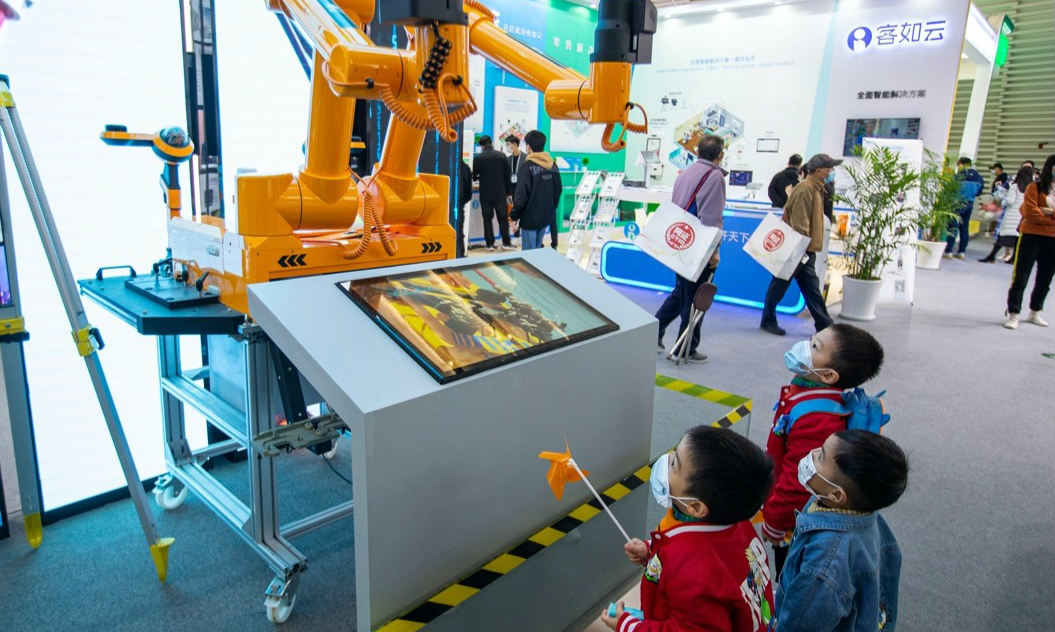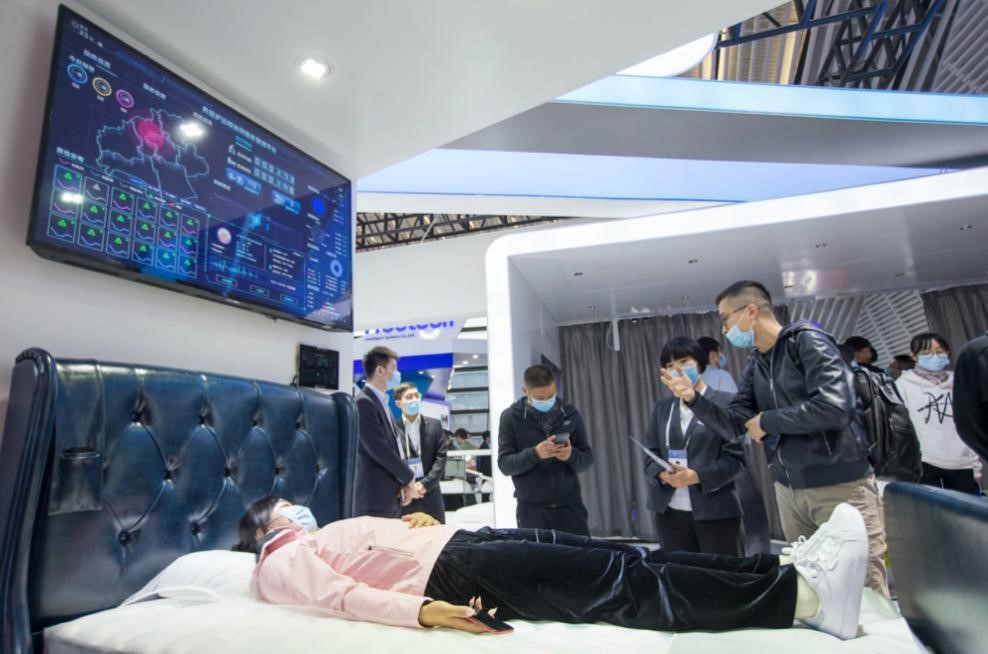

The Light of Internet Expo of the 2020 World Internet Conference (WIC) was held in Wuzhen township, Tongxiang, east China's Zhejiang province, from Nov. 22 to 24.
Focusing on the world's most recent Internet development trends and cutting-edge technologies, the expo attracted a total of 130 well-known companies and institutions, which showcased new digital technologies, products, applications, and results in AI, cloud computing, big data, blockchain, 5G and other fields.

Visitors learn about a high-tech medical waste collection vehicle at the booth of China Mobile during the Light of Internet Expo of the 2020 World Internet Conference (WIC), Nov. 22. (Photo by Zhai Huiyong/People's Daily Online)
At the booth of China Mobile at the expo, a 5G-driven medical waste collection vehicle from Shaoxing, Zhejiang province, drew the attention of visitors.
Equipped with 5G technology, the vehicle could perform such functions as statistical analysis, real-time supervision, panoramic mapping and AI video monitoring, realizing the closed-loop monitoring and online law enforcement of the entire medical waste industry chain.
China Mobile has also helped Shaoxing establish an information platform that could realize full-cycle, intelligent, and closed-loop digital management of industrial solid waste, domestic waste, and construction waste. "The information platform could guarantee that the origin of every single bag of garbage could be traced," said Shen Yuan, a staff member of China Mobile at the booth.
An ocular fundus diseases screening all-in-one machine displayed at the booth of Chinese search engine giant Baidu could scan the eyes of users and provide the results within several seconds.

Visitors view a power distribution robot equipped with 5G and satellite positioning functions at the booth of the State Grid Corporation of China during the Light of Internet Expo of the 2020 WIC, Nov. 22. (Photo by Zhai Huiyong/People's Daily Online)
A technician pointed out that the device can input a two-dimensional photo of the ocular fundus taken by its built-in camera and assess the risks of diseases based on information about the four major physiological structures of the fundus it extracted through deep learning algorithms.
The system is able to spot major eye diseases such as glaucoma, macular degeneration and diabetic retinopathy, helping high-risk groups have their eye diseases detected early.
One of the highlights of the expo is the exhibits showing how industrial Internet applications can improve production efficiency.
At the booth of Seiko Epson Corporation, a special pair of glasses was particularly eye-catching. It turned out to be a remote operation and maintenance support system based on augmented reality (AR) technology.
With the special pair of glasses, workers at the operation and maintenance site of industrial equipment could send high-definition pictures to back-end experts in a real time manner and see the drawings and relevant materials about the equipment provided by back-end experts via a virtual screen, thus receiving guidance on fault diagnosis, operation and maintenance.
During the COVID-19 prevention and control, many companies have asked experts from foreign countries to debug and repair their production equipment remotely through the system, which infused vitality into the resumption of work and production, said Wang Jiahui, a staff member at the booth.

Children interact with Xiaodu, a smart robot rolled out by Chinese search engine giant Baidu, during the Light of Internet Expo of the 2020 WIC, Nov. 22. (Photo by Zhai Huiyong/People's Daily Online)
At the booth of the State Grid Corporation of China at the expo, a power distribution robot was swiftly moving its arms while the images of its operation were displayed on a screen in real time.
By controlling the robot through a terminal box controller, operators could simply stand on the ground and allow the robot to autonomously identify the position of the wire lead and carry out related power distribution tasks through the application of technologies concerning such purposes as 3D reconstruction of environment, visual recognition, and motion control, which is both more efficient and safer.
Exhibits showing roles of science and technology in facilitating public welfare undertakings have also attracted many visitors.
At the booth of China’s tech giant Tencent, visitors could design silk scarves via a mini program, with the design inspiration coming from representative theme elements and more than 200 details from murals in the Mogao Grottoes in Dunhuang, northwest China's Gansu province.

A visitor experiences remote collaborative services concerning elderly care, medical care and nursing during the Light of Internet Expo of the 2020 WIC, Nov. 22. (Photo by Zhai Huiyong/People's Daily Online)
They could also upload photos of themselves and try the scarves they have designed virtually with the help of image processing and facial recognition technologies before placing an order.
By purchasing the scarves, the users will be making donations to the digital protection of the Mogao Grottoes, according to a worker at the booth.
At the expo, China UnionPay displayed several special POS machines, also a public welfare project that enables users to pay one yuan and then get poems written by children from poor mountainous areas.
The money collected in the project will be used to support art education for these children.
Many visitors paid for the poems by scanning a QR code to contribute to improving education in poor areas.
China UnionPay is now expanding online channels for the POS machine to involve more people in the public welfare project, said a worker at the booth.

 Award-winning photos show poverty reduction achievements in NE China's Jilin province
Award-winning photos show poverty reduction achievements in NE China's Jilin province People dance to greet advent of New Year in Ameiqituo Town, Guizhou
People dance to greet advent of New Year in Ameiqituo Town, Guizhou Fire brigade in Shanghai holds group wedding
Fire brigade in Shanghai holds group wedding Tourists enjoy ice sculptures in Datan Town, north China
Tourists enjoy ice sculptures in Datan Town, north China Sunset scenery of Dayan Pagoda in Xi'an
Sunset scenery of Dayan Pagoda in Xi'an Tourists have fun at scenic spot in Nanlong Town, NW China
Tourists have fun at scenic spot in Nanlong Town, NW China Harbin attracts tourists by making best use of ice in winter
Harbin attracts tourists by making best use of ice in winter In pics: FIS Alpine Ski Women's World Cup Slalom
In pics: FIS Alpine Ski Women's World Cup Slalom Black-necked cranes rest at reservoir in Lhunzhub County, Lhasa
Black-necked cranes rest at reservoir in Lhunzhub County, Lhasa China's FAST telescope will be available to foreign scientists in April
China's FAST telescope will be available to foreign scientists in April